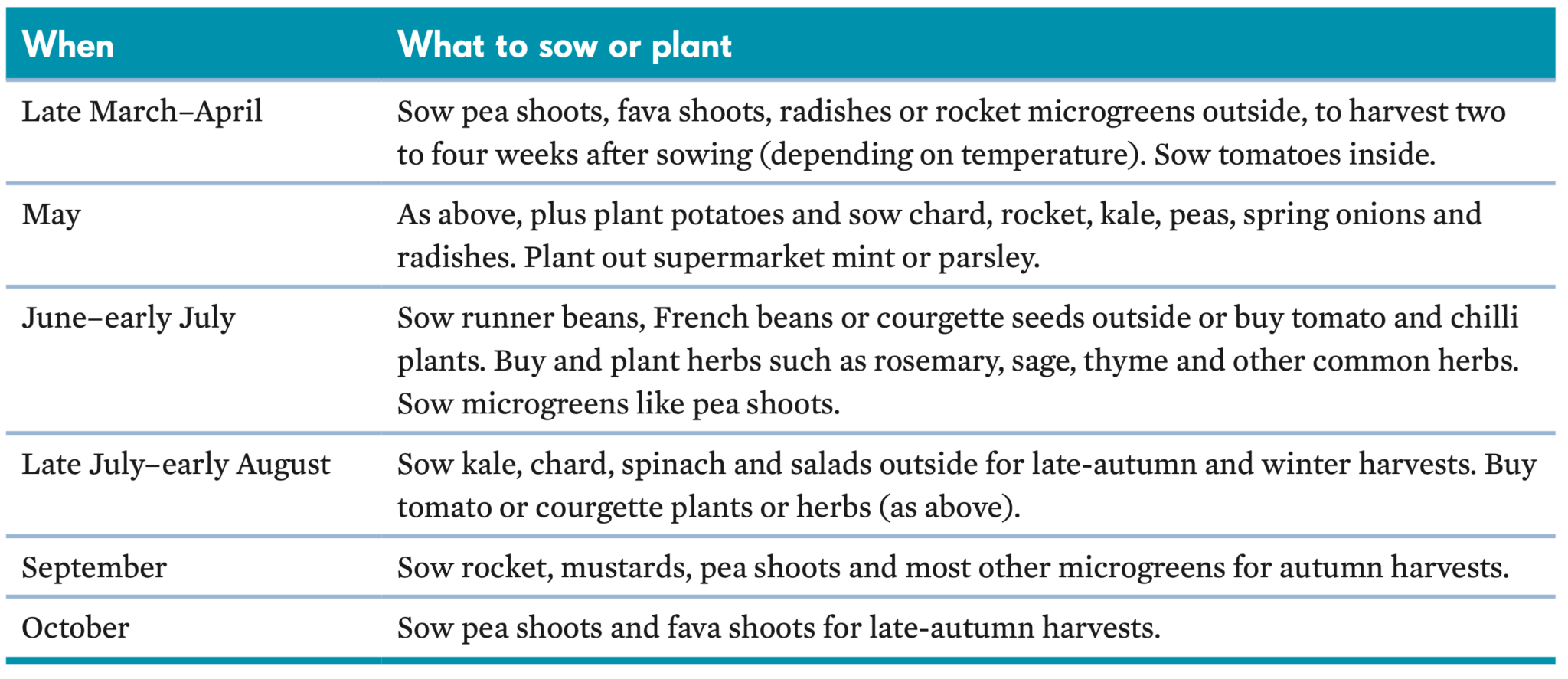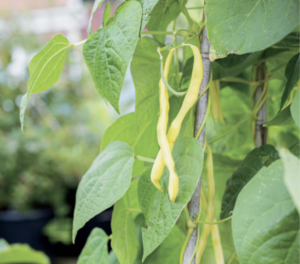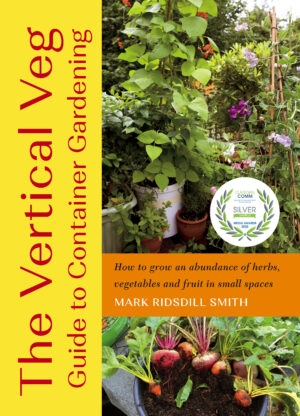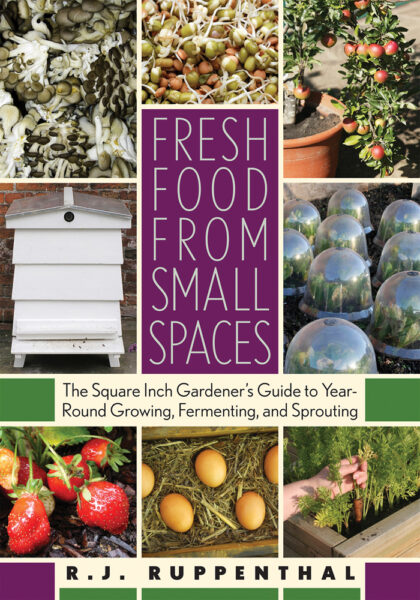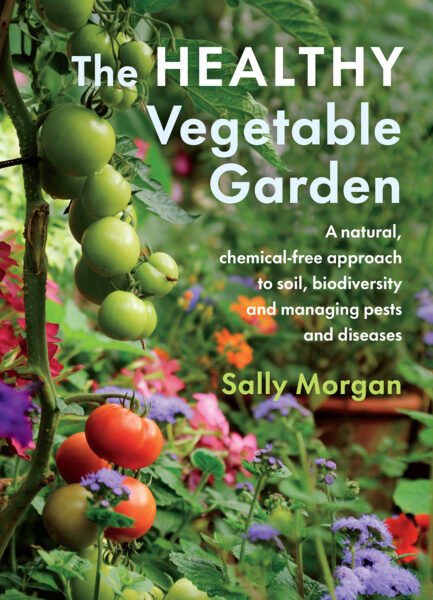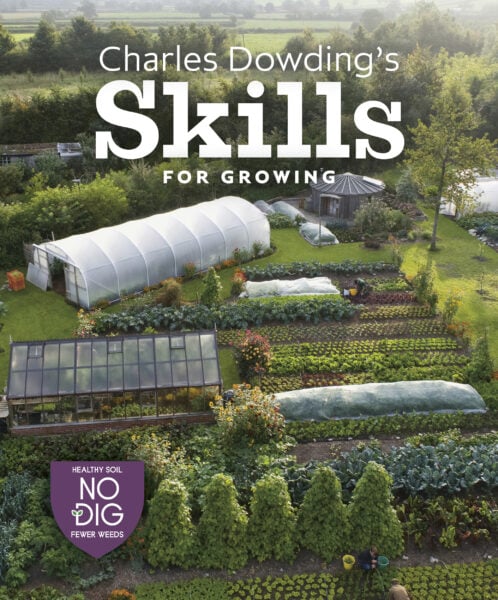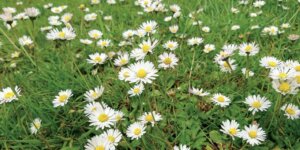What and When to Grow in Containers
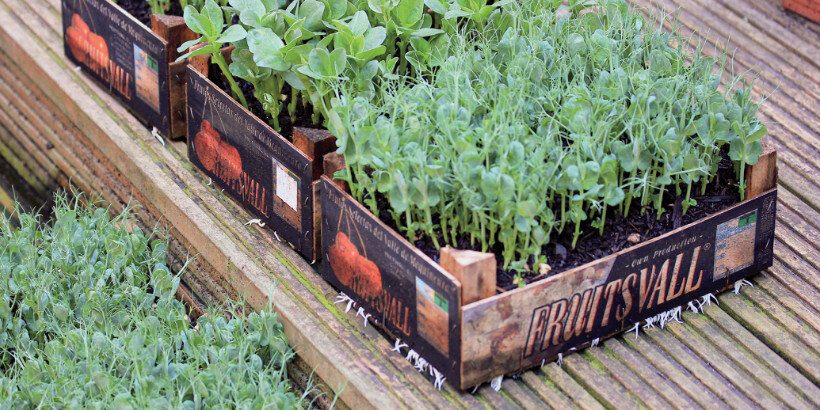
If you’re new to container gardening, knowing what and when to sow seeds can feel overwhelming. Never fear! Below is a list of easy seasonal projects plus a rundown of what an entire year of container gardening can look like. Get ready to grow in containers!
The following is an excerpt from The Vertical Veg Guide to Container Gardening by Mark Ridsdill Smith. It has been adapted for the web.
When to Start Growing
Traditionally, the growing season kicks off in early spring. If you’re new to growing, it’s easy to feel under pressure to sow seeds straightaway. But when the weather is cold, the days are short and light levels are low, it’s harder to coax seeds into life and raise healthy plants. It’s much easier in the warm, brighter days of late spring and early summer. Even mid-summer or early autumn is not too late to start. There is, of course, nothing wrong with starting seeds in early spring; just bear in mind that it does get easier later in the year. Ideas for easy seasonal projects can be found in the table below.
A Plan for A Year
January
- Make a plan for the year. Plant new fruit trees. Order seeds.
February
- Prune and repot fruit trees.
- Sow inside: Chillies, peppers and aubergines later in the month (until mid-March).
March
- Sow inside: Tomatoes (best from late March until the end of April).
- Sow outside in early March: Pea and fava shoots, peas (until April) and Jerusalem artichokes.
- Sow outside in late March: Rocket, mustards, radishes, spring onions and coriander.
April
- Sow inside from mid-April: French and runner beans, nasturtiums, courgettes, squash, cucumbers and New Zealand spinach (all until the end of May).
- Sow outside: Potatoes, beetroot, lettuce, parsley, sorrel, chard, kale, spinach, more salad leaves (such as rocket) and Asian leaves like pak choi.
- Divide and repot mint plants. Repot other herbs in larger pots as needed (or next month).
- A good time to start a wormery (any time until July).
May
- Sow inside: Basil.
- Sow outside: More salads and leafy vegetables like chard if needed. A good month to sow most root vegetables, including beetroot, carrots, leeks and radishes.
- Pot up supermarket herbs and stock up on other herb plants (any time until August). Harden off indoor sowings for a week or two.
June
- Sow outside: French and runner beans, cucumbers, courgettes and squash (if not already sown inside); plus, summer salads like New Zealand spinach, summer purslane, nastur- tiums and lettuce.
- Transplant all indoor sowings outside after the last frost (look this up for your area).
- Support climbing plants like tomatoes and squash as they grow and start pinching out the side shoots on vine tomatoes.
- Start liquid feeding fruiting crops once flowering starts (and keep feeding until fruiting stops).
July
- Sow outside: Bulbing fennel for autumn; mustards, rocket and other salad leaves for early autumn; chard and kale for winter.
- A good month to take herb cuttings.
August
- Sow outside: Mooli, Asian greens like choy sum, mustards and pak choi, and salads such as land cress and lamb’s lettuce for autumn and winter. The best month to sow coriander.
- Mulch hungry crops like courgettes and tomatoes with worm compost if you have it.
September
- Sow outside: Rocket, mustards and other fast-growing leaves in the first half of the month.
October
- Sow outside: Last sowing of pea and fava shoots.
- Order bare-root fruit trees for planting over winter.
- Prepare a wormery for winter.
November
- Reflect on the year: What grew well and what you learned, ready for next year.
- Protect winter crops with cloches or horticultural fleece if needed.
December
- Pick the occasional winter salad treat. Sleep and dream.
- French beans are normally sown inside in April or outside later in May or early June.
Recommended Reads
Recent Articles
With the right strategies and practices, composting on a small farm is surprisingly easy and inexpensive. Just follow these steps for making compost, and your farm will be thriving in no time! The following excerpt is from The Lean Farm Guide to Growing Vegetables by Ben Hartman. It has been adapted for the web. (All photographs by Ben…
Read MoreEveryone loves a refreshing, fermented, nutritious drink…even your garden! Take your fermentation skills out of the kitchen and into the garden by brewing fermented plant juice. The following is an excerpt from The Regenerative Grower’s Guide to Garden Amendments by Nigel Palmer. It has been adapted for the web. How to Make Fermented Plant Juice Fermented…
Read MoreWant to see your crops thrive this upcoming growing season? The key is in soil fertility and health. Spend time maintaining your soil’s health to guarantee bigger and better crops come harvest time! The following is an excerpt from No-Till Intensive Vegetable Culture by Bryan O’Hara. It has been adapted for the web. What Is Soil Fertility?…
Read MoreIt’s time to take control of your seeds and become a plant breeder! Saving your seed allows you to grow and best traditional & regional varieties, and develop more of your own. The following excerpt is from Breed Your Own Vegetable Varieties by Carol Deppe. It has been adapted for the web. Becoming A Plant…
Read MoreRewilding is one of the best things you can do for the biodiversity of your farm or garden. By no longer mowing your lawn, flowers will start to grow, creating a meadow and a habitat for creatures that often get forgotten. The following is an excerpt from The Healthy Vegetable Garden by Sally Morgan. It…
Read More

